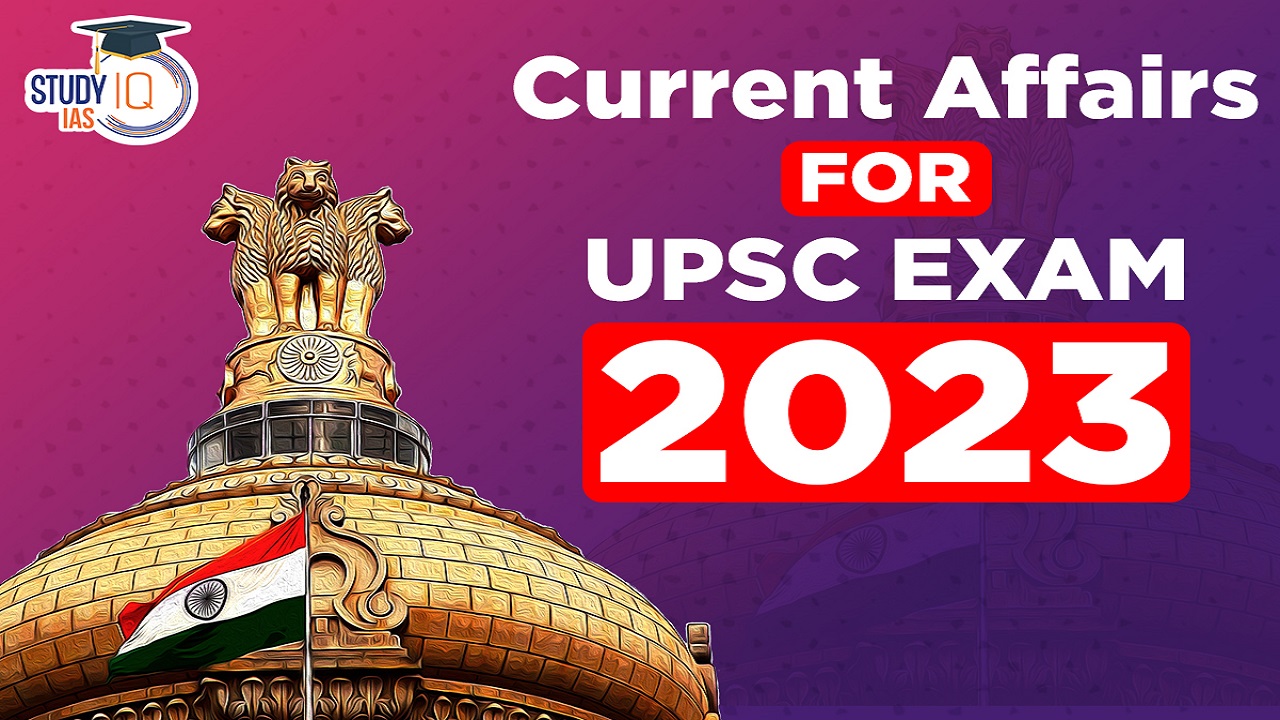Current Affairs 12th June 2023 for UPSC Prelims Exam
Hydrogen from Seawater using Solar Energy
Context: Researchers from IIT-Madras have developed critical components for a cost-effective way to electrolyze seawater to generate hydrogen.
More on the News:
- The existing alkaline water electrolyser technology is energy-intensive, requires an expensive oxide-polymer separator, and uses fresh water for electrolysis.
- In order to overcome these challenges, the IIT team developed simple, scalable and cost-effective alternatives that are highly efficient in splitting seawater and generating hydrogen.
Changes incorporated by the team:
- The team has developed an electrolyser using alkaline seawater instead of pure or freshwater.
- Carbon-based support material was used for the electrodes instead of metals to almost eliminate the possibility of corrosion.
- Transition metal-based catalysts that can catalyse both oxygen and hydrogen evolution reactions, were designed and developed.
- An economical cellulose-based separator was developed that serves the purpose of allowing hydroxide ions to pass through but prevents oxygen and hydrogen that are generated from crossing-over.
- All parameters have been optimized in such a way that water electrolyser can directly use photovoltaic-derived voltage to split seawater and generate green hydrogen and oxygen.

Significance of Research:
- The global manufacturing capacity of electrolysers is at 8 GW/year. In case India is to achieve its 2030 target, it requires 60-100 GW of electrolyser capacity, which amounts to almost 12 times the current global production capacity.
Hydrogen Energy
- Hydrogen has been given colour spectrum (green, blue, grey, black, and brown) depending on the ability to totally avoid or capture the greenhouse gases emitted in the process.
- Green hydrogen: Hydrogen is produced through water electrolysis. When the electricity used in the water electrolysis is obtained from renewables, it is classified as green hydrogen.
- Mission: The National Hydrogen Mission aimed at producing 5 MMT per annum with an associated renewable energy capacity addition of about 125 GW by 2030.
- Usage: Green hydrogen has the potential to reduce carbonization of the energy sector and the use of energy in end-use sectors such as transport, buildings and industry.
- Benefits: Green hydrogen has potential to generate savings to the tune of $12.5 billion from fuel imports, avoid 50 MMTs of annual CO2 emissions, fresh investments to the tune of $100 billion in the sector, and generate 6,00,000 green jobs.
Current Affairs 10th June 2023 for UPSC Prelims Exam
SAGAR SAMRIDDHI
Context: Union Minister of Ports, Shipping & Waterways (MoPSW) and Ayush, launched ‘SAGAR SAMRIDDHI’ to bring transparency & efficiency.
About SAGAR SAMRIDDHI
- It is an online dredging monitoring system, to accelerate ‘Waste to Wealth’ initiative of the Government.
- It has been developed by National Technology Centre for Ports, Waterways and Coasts (NTCPWC) the technological arm of MoPSW.
- Capabilities of ‘Sagar Samriddhi’ include:
- Real time dredging progress report.
- Daily and monthly progress visualization.
- Dredger performance and downtime monitoring.
- Easy location track data with snapshot of loading, unloading and idle time.
- Significance of SAGAR SAMRIDDHI
- It brings in marked improvement against the old system of Draft & Loading Monitor (DLM) system.
- It will bring in synergy among multiple input reports like daily dredging report, the pre and post dredging survey data before processing and producing real time dredging report.
- It will allow Daily and monthly progress Visualization, dredger performance and downtime monitoring, easy location track data with snapshot of loading, unloading and idle time .T
Dredging Guidelines for Major Ports, 2021
- It outlined the procedure for planning and preparation, technical investigations, dredged material management, estimating the cost of dredging etc., to enable the Major Ports to formulate the dredging projects in order to complete in time.
MARITIME INDIA VISION 2030
- It enables preparation of roadmap for taking up projects including dredging projects.
- It envisages developing Major Ports as trans-shipment hubs wherever possible and increasing their capacity by way of deepening their channels and near berths.
National Technology Centre for Ports, Waterways and Coasts (NTCPWC)
- NTCPWC was established under the Sagarmala Programme of MoPSW with the total investment of Rs 77 Crore, at IIT Madras.
- Aim: To enable research & development for the marine sector, enabling solutions towards achieving the ultimate goal of building a robust marine industry in the country.
Genetic Engineering Appraisal Committee (GEAC)
Context: Gujarat, Maharashtra and Telangana, have rebuffed a proposal, approved by the Centre’s Genetic Engineering Appraisal Committee (GEAC), to test a new kind of transgenic cotton seed.
About Genetic Engineering Appraisal Committee (GEAC):
- It is a statutory committee constituted under the “Rules for the Manufacture, Use/Import/Export and Storage of Hazardous Micro Organisms/Genetically Engineered Organisms or Cells (Rules, 1989)” framed under the Environment (Protection) Act, 1986.
- GEAC functions under the Ministry of Environment, Forest and Climate Change (MoEF&CC).
- GEAC is chaired by the Special Secretary/Additional Secretary of MoEF&CC and co-chaired by a representative from the Department of Biotechnology (DBT).
- Functions of GEAC
- In accordance with Rules, 1989, it is in charge of evaluating from an environmental perspective operations involving extensive use of risky microorganisms and recombinants in research and industrial production.
- Evaluating requests for the release of genetically modified (GE) products and organisms into the environment, including field tests.
- It regulates the consumption of genetically modified (GM) animals and plants as well as their import and export.
About GM Crops
- Genetically modified organisms (GMOs) can be defined as organisms (i.e. plants, animals or microorganisms) in which the genetic material (DNA) has been altered in a way that does not occur naturally by mating and/or natural recombination.
- The technology is often called “modern biotechnology” or “gene technology”, sometimes also “recombinant DNA technology” or “genetic engineering”.
- Method: It allows selected individual genes to be transferred from one organism into another, also between non-related species.
- GM Food: Foods produced from or using GM organisms are often referred to as GM foods.

GM Crop in India
- Global Rank: India ranks 5th in global cultivation of GM crops.
- Transgenic cotton is the only GM crop which has been approved and is currently being cultivated in farmer’s fields in India.
- Transgenic mustard was approved by the GEAC, but additional tests have been prescribed before it is fully approved for widespread cultivation.
Project Akashteer
Context: Indian Army is seen transforming the Army Air Defence (AAD) through Project Akashteer.
About Army Air Defence (AAD)
- Aim: To provide Point Air Defence to the nation’s key assets, such as nuclear facilities, oil refineries, military airbases, military-industrial complexes, communication nodes, logistic nodes, gun areas, surface-to-surface missiles, and so forth.
- It is formerly known as Air Defence Artillery until 2005, has been in operation since 1940.
- However, after 1996, the AAD’s modernization stalled.
About Akashteer
- Project Akashteer is implementing a variety of new systems, most of which are indigenous, to create a comprehensive air defence picture for the monitoring, tracking, and shooting of air defence assets.
- It connects all of the AAD’s radars and control centres, unify the air defence image, eliminate overlaps or duplications, and also integrate all of the weaponry.
- The needs for air defence on the northern frontiers differ from those on the western front. The project takes this into consideration.
Need for Transforming
- The acquisition of lightweight radars and mobile weapon systems suitable for hilly terrain and infantry requirements is required as a result of the Army’s shifting attention from the western border with Pakistan to the northern boundaries.
- Indian Army is focusing on laser beam-riding Man Portable Air Defence Systems (MANPADS) with night vision capabilities.
- The needs have also evolved as a result of the conflict in Ukraine, prompting the army to take into account fresh dangers to air defence, including unmanned aerial vehicles (UAVs), loitering weapons, swarm drones, and cruise missiles.
Rail Interlocking System
Context: An electronic track management system used by the Railways has become the focus of investigation after the multi-train crash in Balasore district of Odisha.
What is an Interlocking System?
- An interlocking system is a critical component of railway signaling and is used to manage and control the safe movement of trains and track configurations at stations and junctions.
- Its main purpose is to prevent conflicting movements by ensuring that a train can proceed only when its intended route is set, locked, and verified as safe.
Components of Interlocking System
- The interlocking system consists of a set of apparatus, which can be interconnected mechanically or electrically with the tracks, or both.
- In traditional relay interlocking systems, mechanical and electrical components are used, while electronic interlocking (EI) systems employ computer-based technology and electronic equipment.
- In an electronic interlocking system, the interlocking logic is managed through software and electronic components.
- The system reads inputs from the yard and control panel, processes them in a fail-safe manner, and generates the required outputs.
- The signal apparatus, directs trains to stop (red light), proceed (green), or exercise caution (yellow) based on the status of the track ahead.
- Points are movable sections of the track that allow trains to switch lines, and electric point machines lock and unlock point switches in the desired position.
- Track circuits are electrical circuits installed on the tracks to detect the presence of trains and verify the safety of the track for train movement.

How does the system work?
- The interlocking system works by receiving commands and collecting information from the yard.
- The information is processed to determine a safe route, and the signaling devices are interlocked at the appropriate positions.
- Trains are given a signal to proceed only if the track is set in the correct direction and the divergent track is clear of any obstructions.
- When a train needs to switch lines, the system directs it to an empty track at the point where two lines meet.
- Track circuits ensure that multiple trains do not enter the same block of track to prevent collisions.
- The points remain locked until the train has crossed a specific section of the track or until the signal to proceed has been withdrawn.
- In the event of a system failure, the interlocking system will indicate the lack of a clear and safe route ahead by flashing a red light.


 Sanitary Waste Management Model of Karad...
Sanitary Waste Management Model of Karad...
 Global Labour Shortage and Opportunities...
Global Labour Shortage and Opportunities...
 Gutti Koya Tribals in Post-Conflict Indi...
Gutti Koya Tribals in Post-Conflict Indi...





















